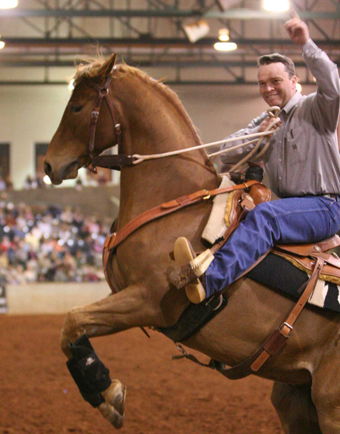 There are many different bits out there and each has its advantages and disadvantages in certain situations and applications. There are two main types of equipment available when you are looking at headgear for your horse. The first is a bit, which works off pressure in your horse’s mouth. The second is a hackamore, which works mainly off pressure on the nose. There are three main sub-categories within each of these types.
There are many different bits out there and each has its advantages and disadvantages in certain situations and applications. There are two main types of equipment available when you are looking at headgear for your horse. The first is a bit, which works off pressure in your horse’s mouth. The second is a hackamore, which works mainly off pressure on the nose. There are three main sub-categories within each of these types.
The first type of bit is called a snaffle. The term snaffle can be applied to any bit where the headstall and rein connect to the same ring. There are many different types of snaffle mouthpieces. The snaffle does not give you any leverage. A snaffle is generally a mild bit. Just be aware that you never should cross your reins under the horse’s neck and ride so the left rein is in your right hand and the right rein in your left hand. This can cause a “nutcracker” effect in the horse’s mouth. The snaffle is a teaching bit, and I like my horses to be trained to do any maneuver, even advanced ones, in a snaffle.
The second type of bit is called a shank, curb, or leverage bit. This type of bit is defined as the headstall and rein connecting to different rings on the bridle. There are thousands of different combinations of mouthpieces and shanks that can make up a leverage bit. You can determine how much leverage a bit has by making two measurements. One is from the top of the mouthpiece to the top of the purchase (the area between the top of the mouthpiece and where the headstall connects to the bit), and the other is from the bottom of the mouthpiece to the bottom of the shank. Then divide the shank measurement by the purchase measurement. For example, if your bit has a 2 1/2″ purchase and a 5″ shank, your leverage ratio is 2:1. This means that for every one pound of pressure you apply on the reins, your horse will feel 2 pounds of pressure.
The third type of bit is the signal or spade bit. These bits are designed to communicate with very little rein movement or pressure. When you pick up on the reins of a signal bit, the spade shaped part of the bit will contact the roof of the horse’s mouth and move on the tongue, sending a signal that the horse has been trained to understand. Spade bits have a bad reputation, which is not completely deserved in my opinion. While it is true that a spade bit in rough hands can be very severe and heavy, traditionally spade bits were connected to the bit by chains for weight, and these chains were supposed to be tied by only one strand of your horse’s tail hair. If the hair broke you were being too heavy handed. These bits were designed for precise communication.
Then you have hackamores, or bitless bridles. The first type of hackamore is called a bozelle. It works mostly off pressure on the lower jawbone, with a little pressure on the nose as well. It is a basic hackamore, and is almost like riding in a more aggressive rope halter. It is like a snaffle bit in that it is direct pull, and does not give you any leverage.
The second type of hackamore is the mechanical hackamore. I am going to say right off that I really don’t like these, and they are quite possibly my least favorite piece of equipment out there. I have seen horses develop some bad habits as a result of mechanical hackamores. If the hackamore sits too low, it will pinch the soft cartilage of the horse’s nose and cut off their air supply every time the rider picks up the reins. This will cause the horse to panic and throw his head up in the air to get a breath. When he does throw his head, the hackamore moves temporarily off his nose, rewarding him with a breath. Then the rider will get frustrated at the head throwing, pick up the reins, and cut off the horse’s air again. Also, I have seen many horses learn to reach sideways and grab the shanks of the mechanical hackamore in their teeth, making it so the rider has no effective use of that rein. The mechanical hackamore is similar to a shank bit in that it gives you leverage. It applies pressure to the nose, curb, and poll. If you do use a mechanical hackamore, make certain that it is adjusted properly and sits above the soft cartilage of the nose so you don’t cut off your horse’s air.
The third type of hackamore is called a sidepull hackamore. This is a little like riding in a more aggressive flat nylon halter. Like all the hackamores, it is important that you adjust this properly so it does not cut off your horse’s wind. Most side pull hackamores have a stiff rope nose band, and I have found that sometimes it will rub on the bridge of my horse’s nose. If you have that problem, you can wrap it in vet wrap to make it softer.
I believe there is no such thing as a hard mouthed horse. There are only hard headed horses. Hard headed horses learn to ignore pressure on the bridle because people have continually increased the amount of pressure they are applying without rewarding the horse for the desired response.
I often get asked when to move to a leverage bit from a snaffle. I don’t use a leverage bit until I can get my horse to do everything I want in a snaffle. I do not use a leverage bit for training purposes, or because I can’t get my horse to do something in a snaffle. The reason I might switch my trained horses to a leverage bit is that it is better designed for one handed riding. Remember that if you do switch to a leverage bit, you will need to be very aware of how much pressure you are putting on the reins and lighten your hands drastically from using a snaffle. When you use a leverage bit, the horse not only feels pressure in his mouth, but also on the curb strap and poll.
Enjoy your horses and until next time, may God bless the trails you ride.
For more information on Ken McNabb’s programs call us at 307-645-3149 or go to www.kenmcnabb.com




